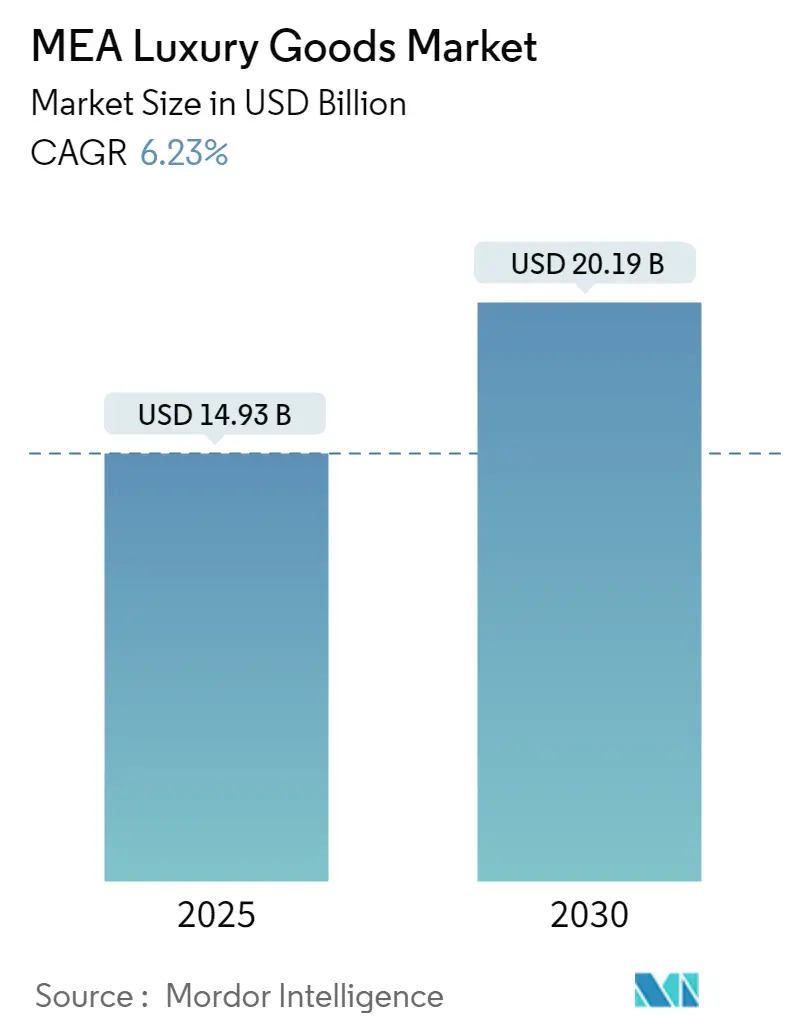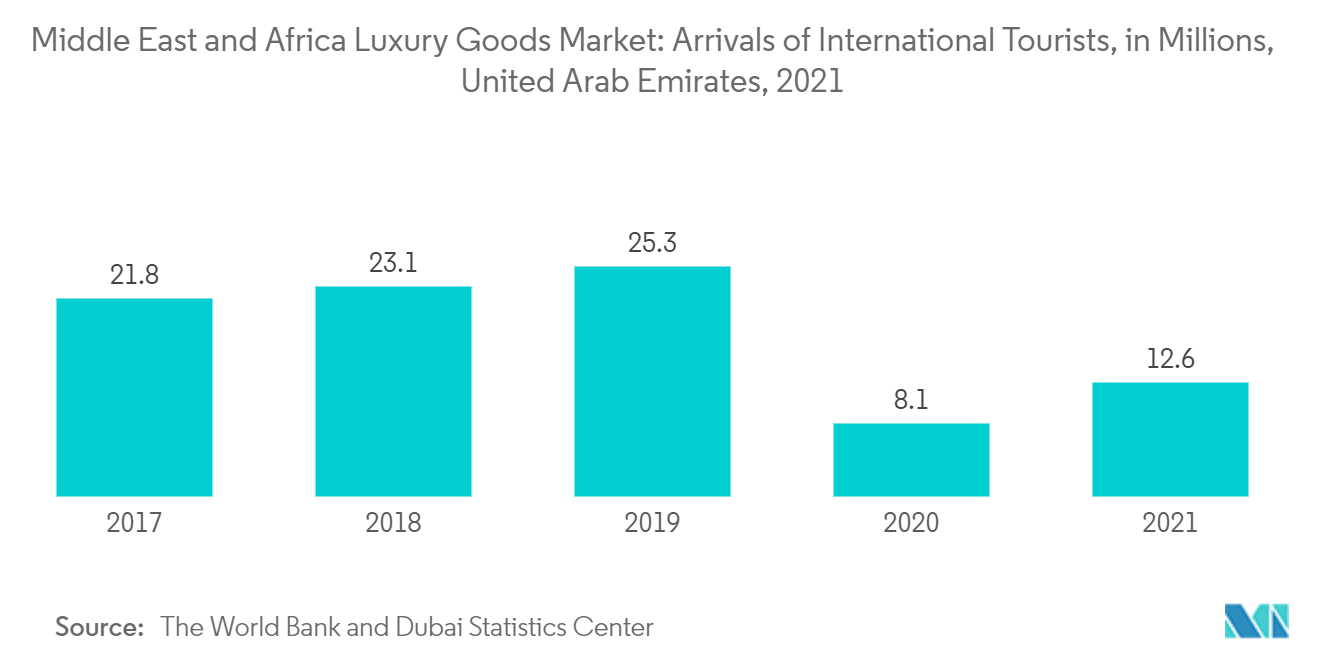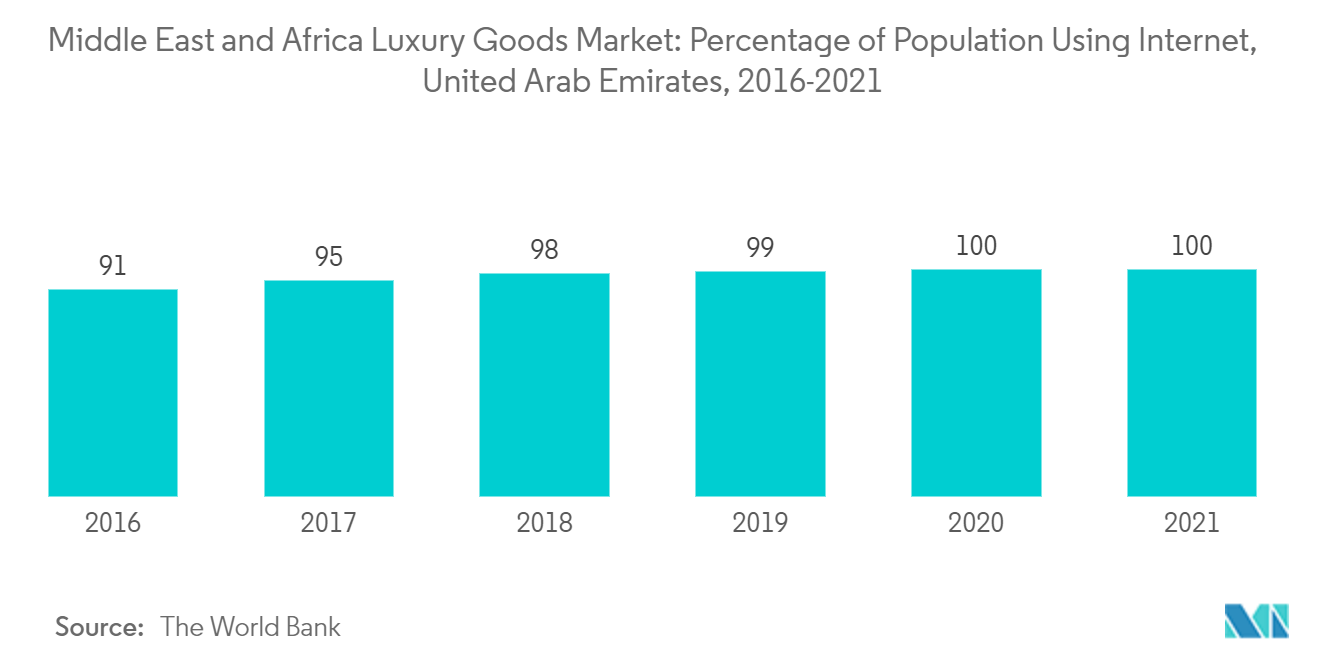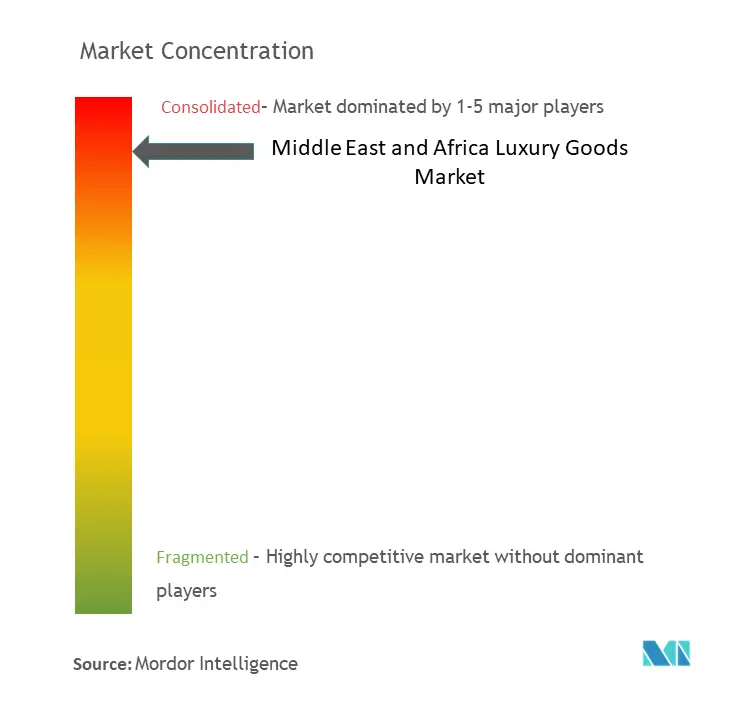
| Study Period | 2019 - 2030 |
| Base Year For Estimation | 2024 |
| Forecast Data Period | 2025 - 2030 |
| Market Size (2025) | USD 14.93 Billion |
| Market Size (2030) | USD 20.19 Billion |
| CAGR (2025 - 2030) | 6.23 % |
| Market Concentration | High |
Major Players.webp)
*Disclaimer: Major Players sorted in no particular order |
Middle East & Africa Luxury Goods Market Analysis
The MEA Luxury Goods Market size is estimated at USD 14.93 billion in 2025, and is expected to reach USD 20.19 billion by 2030, at a CAGR of 6.23% during the forecast period (2025-2030).
In the Middle East and Africa, especially in GCC countries, more than half of the consumers claim to have increased their spending on luxury goods. In the past few years, the Middle East luxury goods industry has been through a period of expansion, as major companies have grown by extending the reach of their brand distribution network and opening new stores in the region. Consumers in countries such as Saudi Arabia prefer luxury goods over conventional ones, owing to their high purchasing power and sustainable demand for these products that reflect their social status. In March 2022, Kering Group's Gucci debuted its glittering high jewellery pieces encompassing necklaces, rings, and bracelets to the United Arab Emirates for the first time, transforming a villa on Palm Jumeirah into a garden for the occasion.
Over the long term, the luxury goods market in the Middle East and Africa is expected to grow because of the increase in disposable income, growing millennial population, increasing tourism, and penetration of global market players in the region. Global market players like Gucci, LMVH, PVH, and Rolex are launching their products in the market, which is grabbing the attention of consumers. For instance, in July 2021, Versace unveiled its new boutique at The Galleria Al Maryah Island, Abu Dhabi, expanding the destination's exceptional portfolio and reinforcing the mall's position as the premier luxury and retail destination in the capital. The e-commerce websites are also growing in the region, which is expected to drive the market over the medium term.
Middle East & Africa Luxury Goods Market Trends
Rise in Tourism Expected to Drive the Market
- Many nations across the Middle East and Africa have gained popularity across the globe as tourism spots. For instance, with its opulent architecture, staggering skylines, and enormous shopping complexes, Dubai has become one of the most identifiable destinations in the world. Dubai is a potential and attractive location for short vacations as it offers an array of cuisines, shopping options, and sporting events.
- According to data from the World Bank and Dubai Statistics Center, approximately 12 million foreign visitors arrived in the United Arab Emirates in 2021. Hence, the region attracts a substantial number of tourists, which drives the market studied.
- Furthermore, owing to the rise in demand for luxury goods and the various opportunities available in the market, multiple players have been entering the market, and the existing players have been using strategies to strengthen their presence in the market. For instance, Bayt Damas, a luxurious time capsule that brought together prestigious brands such as Sabyasachi Jewellery, Graff, and Mikimoto, was inaugurated in Dubai. This all-encompassing luxury experience, which opened its doors in May 2021, curated a collection of exquisite jewelry, fashion, and art while promoting regional luxury brands within a single destination.
- Additionally, tourists often come across things that the Middle East is famous for, such as perfumes and leather products. For instance, the luxury goods brand, Gucci, has a product portfolio in the United Arab Emirates that comprises more than 29 variants of perfumes. Hence, the rise in tourism across the region and the robust luxury market infrastructure are expected to drive the Middle East and African luxury goods market over the next few years.

United Arab Emirates Dominates the Market
- The United Arab Emirates has a huge demand for luxury goods due to high disposable income, increasing tourism, and its young population. Tourism in the United Arab Emirates is constantly growing because of the tourist spots in the region. International visitors often visit the region due to its food culture, jewelry goods, and many more.
- Internet usage across the region has also played a key role in driving the sales of luxury goods nationwide. Across the region, the population is exposed to a multitude of influencers and advertising campaigns promoting a wide range of luxury goods, including handbags, jewelry, and footwear, through various social media platforms. Hence, Internet penetration across the region has also played a key role in the expansion of the market studied.
- As per the World Bank data, the percentage of the population using the internet in the United Arab Emirates was 100%. The penetration of e-commerce websites in the country allows consumers to have multiple options for luxury goods, which also drives the market.
- In April 2022, a luxury fashion firm named Business of Preloved Fashion (BOPF) entered the market in the United Arab Emirates, introducing an online marketplace that connects buyers and sellers. Additionally, the region has witnessed a growing acceptance of online sales channels for various reasons, such as the convenience of shopping, the time-saving features of online platforms, and doorstep delivery options. Consequently, multinational and premium brands frequently choose to launch their products in the region through online platforms, which is expected to contribute to the market's growth in the near future.

Middle East & Africa Luxury Goods Industry Overview
The Middle East and Africa luxury goods market is a competitive market with the presence of various major players, such as Rolex SA, LVMH Moët Hennessy Louis Vuitton, Kering S.A., Compagnie Financière Richemont S.A., and Chanel SA. The key luxury goods players are embarking on mergers and acquisitions and entering into partnerships /agreements as one of their key strategies to achieve consolidation and optimize their offerings.
Major players are focusing on introducing new product offerings in the market to cater to the interests of the consumers as per ongoing fashion trends among goods, like footwear, accessories, and luggage bags. Since leather products have a significant role to play in the luxury goods market, top companies are engaged in delivering quality leather product offerings for fashion-inspiring consumers.
Middle East & Africa Luxury Goods Market Leaders
-
Rolex SA
-
LVMH Moët Hennessy Louis Vuitton
-
Kering S.A.
-
Compagnie Financière Richemont S.A.
-
Chanel S.A
- *Disclaimer: Major Players sorted in no particular order

Middle East & Africa Luxury Goods Market News
- November 2022: Santos de Cartier launched new series of jewelry collections that consists of rings, bracelets, and necklaces. The collection consists of a gold chain in two colors, mounted with a single or double row of coffee beans decorated with diamonds of various sizes.
- May 2022: PRADA Tropico expanded its presence by launching an exclusive pop-up boutique in Dubai. Located at the Mall of Emirates, the store has colorful luxury accessories, ranging from raffia-style bags to bold and bright hats and small accessories. The pop-up store uses multiple combinations of colored stripes and vibrant lighting effects to create a hypnotic retail experience.
- May 2021: A new Rolex Boutique opened at the Galleria Al Maryah Island in Abu Dhabi, the capital of the United Arab Emirates. The boutique features a "watchbar" and various seating areas where clients are welcome to sit, as well as a VIP room that proudly displays the extensive collection.
Middle East & Africa Luxury Goods Industry Segmentation
Luxury goods are premium, high-quality products that are not necessary for living but add value to consumers' appearance.
The Middle East and African luxury goods market is segmented by product type, distribution channel, and country. By product type, it is segmented into clothing and apparel, footwear, bags, jewelry, watches, and other accessories. The manufacturers operating in this segment are adopting various distribution networks to increase their consumer base, including single-branded stores, multi-brand stores, online retail stores, and other distribution channels. The market is thoroughly studied for different countries under the region, such as the United Arab Emirates, Saudi Arabia, Qatar, South Africa, and the Rest of the Middle East and Africa.
For each segment, the market sizing and forecasts have been done based on value (in USD).
| Product Type | Clothing and Apparel |
| Footwear | |
| Bags | |
| Jewelry | |
| Watches | |
| Other Accessories | |
| Distribution Channel | Single-branded Stores |
| Multi-brand Stores | |
| Online Retail Stores | |
| Other Distribution Channels | |
| Geography | Saudi Arabia |
| United Arab Emirates | |
| Qatar | |
| South Africa | |
| Rest of Middle East and Africa |
Middle East & Africa Luxury Goods Market Research FAQs
How big is the MEA Luxury Goods Market?
The MEA Luxury Goods Market size is expected to reach USD 14.93 billion in 2025 and grow at a CAGR of 6.23% to reach USD 20.19 billion by 2030.
What is the current MEA Luxury Goods Market size?
In 2025, the MEA Luxury Goods Market size is expected to reach USD 14.93 billion.
Who are the key players in MEA Luxury Goods Market?
Rolex SA, LVMH Moët Hennessy Louis Vuitton, Kering S.A., Compagnie Financière Richemont S.A. and Chanel S.A are the major companies operating in the MEA Luxury Goods Market.
What years does this MEA Luxury Goods Market cover, and what was the market size in 2024?
In 2024, the MEA Luxury Goods Market size was estimated at USD 14.00 billion. The report covers the MEA Luxury Goods Market historical market size for years: 2019, 2020, 2021, 2022, 2023 and 2024. The report also forecasts the MEA Luxury Goods Market size for years: 2025, 2026, 2027, 2028, 2029 and 2030.
Our Best Selling Reports
Middle East & Africa Luxury Goods Industry Report
Statistics for the 2025 MEA Luxury Goods market share, size and revenue growth rate, created by Mordor Intelligence™ Industry Reports. MEA Luxury Goods analysis includes a market forecast outlook for 2025 to 2030 and historical overview. Get a sample of this industry analysis as a free report PDF download.




